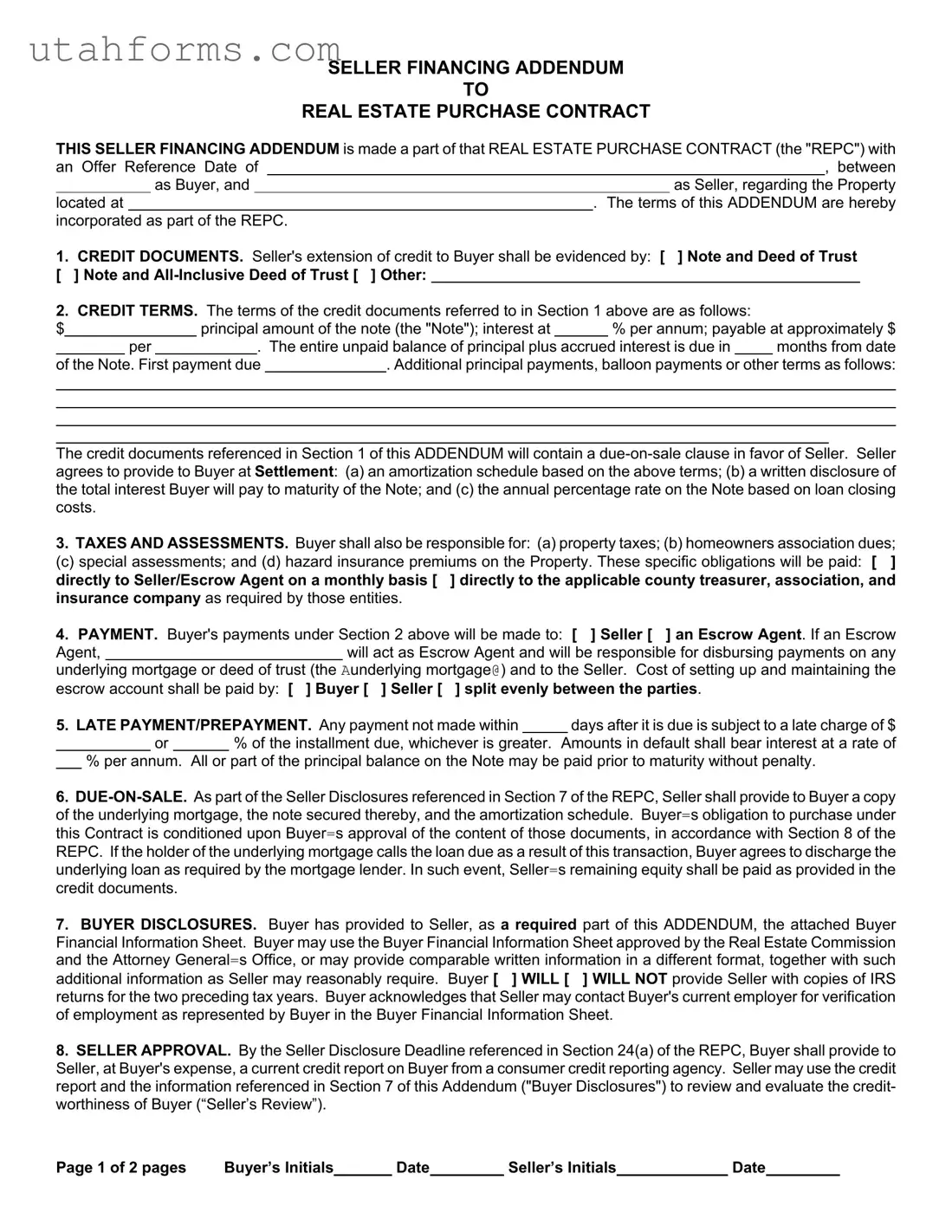The Real Estate Purchase Contract (REPC) is fundamentally similar to the Seller Financing Addendum as it sets forth the terms and conditions under which property is sold and purchased, albeit without the specific financing details. The REPC outlines the agreement between the buyer and the seller, including property details, offer price, and contingencies like inspections and financing. When the Seller Financing Addendum is made a part of the REPC, it specifically integrates the terms under which the seller will finance the purchase for the buyer, supplementing the basic agreement with detailed financing conditions.
The Note and Deed of Trust document shares similarities with the Seller Financing Addendum by detailing the financial obligation of the buyer to the seller (or lender) and securing it with the property as collateral. This document outlines the loan amount, interest rate, repayment schedule, and the legal steps the lender can take if the borrower fails to make payments. The Seller Financing Addendum refers to these financing instruments as means to detail the credit arrangement directly between buyer and seller, effectively making the seller the lender.
An All-Inclusive Deed of Trust (Wrap-Around Mortgage) is another financial document that bears resemblance to the Seller Financing Addendum. This type of deed of trust allows a buyer to assume the seller's existing mortgage while creating a new, larger loan. It’s similar because it directly involves seller-assisted financing, wrapping an existing loan with new financing terms, which the addendum may specify as part of the seller financing solution.
Amortization schedules, referenced in the Seller Financing Addendum, are also standalone documents. They lay out in detail the schedule of payments for a loan, showing how much of each payment goes towards the principal vs. interest over the life of the loan. This document is crucial in seller financing arrangements to clearly understand the repayment plan, aligning with the addendum’s provision to provide such a schedule to the buyer.
The Late Payment Policy document, mirroring aspects of the Seller Financing Addendum, outlines the consequences of late payments on a loan, including any late fees and the rate of interest on overdue amounts. Such policies are standard practice in lending to ensure borrowers are clearly aware of the repercussions of failing to make timely payments, a principle also encapsulated in the addendum’s terms.
A Due-on-Sale Clause Agreement, like the one contemplated in the Seller Financing Addendum, is a document or clause within a mortgage that requires the full loan balance to be paid if the property is sold. This clause protects the lender by preventing the loan from being assumed by another party without approval. The addendum’s inclusion of a due-on-sale clause ensures the seller retains this protective measure when providing financing.
The Buyer Financial Information Sheet, required by the Seller Financing Addendum, is akin to loan application documents used in standard mortgage processes. It collects the buyer's financial data, enabling the seller to assess the buyer’s creditworthiness. This documentation is part of the seller's due diligence in a seller-financed transaction, comparable to a lender’s review in a traditional mortgage application.
A Credit Report Authorization form is closely related to the credit review steps mentioned in the Seller Financing Addendum. It permits the seller to obtain and review the buyer’s credit report as part of evaluating the buyer's ability to fulfill the financial obligations outlined in the seller financing agreement. This step is common in both traditional and seller-financed transactions to ensure the financial risk is acceptable.
Title Insurance Commitment Letters are related to the Seller Financing Addendum in that they ensure the property being financed is free of liens or encumbrances that could affect the sale. The addendum mentions that the buyer should provide title insurance to protect the seller’s interest, ensuring that the title is clear and the seller’s security in the property is intact.
The IRS Form 1098 or Mortgage Interest Statement is a document required for reporting mortgage interest paid by a borrower during the year. It is related to the Seller Financing Addendum’s mention of the disclosure of Social Security Numbers or tax identification numbers for IRS reporting purposes. This document facilitates compliance with federal tax laws, underscoring the addendum’s alignment with legal reporting requirements.


